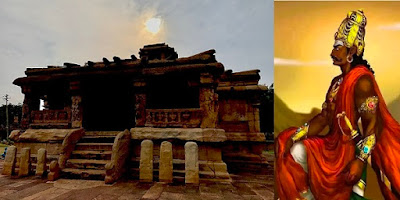Karnataka is replete with ancient wealth, many unique structures associated with history can be seen here in their early form. Situated at a distance of about 500 km from Bangalore, Aihole serves as an ancient scene. Aihole is one of the famous tourist attractions in Karnataka.
Aihole, a small village in Karnataka, is a home to astonishing ancient Hindu Temple architectures. In this historic center every temple has something extraordinary to explore.
A temple, that carries ancient heritage, is a beautiful gift of the past given to the modern world. No doubt temples are the divine stages that unite the past with the present.
One such ancient temple is the Lad Khan Temple, dedicated to Lord Shiva, which still stands with thousands of years of history. It was constructed by the rulers of Chalukya dynasty in the early 5th century. This temple was constructed in a different style during the Chalukya period. The architecture of this temple is quite different from the rest of the temples built during that period.
In fact it feels like a mandapa with a set of 12 carved pillars. However, no temple can have only a mandapa, the rest of the temple may have been destroyed by the invader and only the mandapa remains. there is no pradakshinapatha surrounding the main temple.
To enter the maha mandapa, one has to pass through the Shobha Mandapa where the pillars are arranged in order to form two concentric squares. The interior walls have sculptures portraying the Hindu mythologies, along with the interesting tales. Facing the sanctuary, the second smaller sanctuary is located above the middle of the hall, which the exterior walls have many sculpted images. The temple was constructed in the style of Panchayatana, indicating a very early assessment of the construction of the temple. Usually ancient Hindu temples are built in Panchayatana style. A Hindu temple is considered as Panchayatana one while the original temple is surrounded by four auxiliary temples. The origin of the name is the Sanskrit word Panch (five) and Ayatana (Volume). Here the word Ayatana indicates volume of five temple rooms. Generally, the Hindu temples are constructed along a west-east axis, So the four auxiliary temples are northeast, southeast, southwest, northwest. The unique characteristic of this temple is that it begins with a rectangular structure and completes with a square structure. The square and rectangular plan, based on a wooden structure, has a steep roof that adapts wooden styles in stone. The roof above the maha mandapa shows a turret typed small room as a first version of the shikharas and vimanas.
Carving of Lord Sun, Garura and other deities can be seen on the walls, and there is an ancient Shiva Lingam with nandi in the main sanctum of the temple which confirms the temple is an ancient Shiva Temple.Considering all the architectural features, the Ladakhan Temple is considered to be an important stage of development of the early Chalukyan art.
 |
| Lad Khan Temple - 5th Century Chalukyan Architecture |
A temple, that carries ancient heritage, is a beautiful gift of the past given to the modern world. No doubt temples are the divine stages that unite the past with the present.
One such ancient temple is the Lad Khan Temple, dedicated to Lord Shiva, which still stands with thousands of years of history. It was constructed by the rulers of Chalukya dynasty in the early 5th century. This temple was constructed in a different style during the Chalukya period. The architecture of this temple is quite different from the rest of the temples built during that period.
Temple Science
The Ladakh Temple is one of the important shrines in Aihole because of the construction technique which represents the significant phase of the evolution of the Chalukyan architecture style. The temple consists of small garbha griha (sanctuary) with mandapa in front of it. The temple has an unique design and it doesn't look like a temple initially.In fact it feels like a mandapa with a set of 12 carved pillars. However, no temple can have only a mandapa, the rest of the temple may have been destroyed by the invader and only the mandapa remains. there is no pradakshinapatha surrounding the main temple.
 |
| Image Source: Wikipedia |
 |
| Image Source: Wikipedia |
No comments:
Post a Comment
Please do not enter any spam link in the comment box. Thanks for reading our articles.